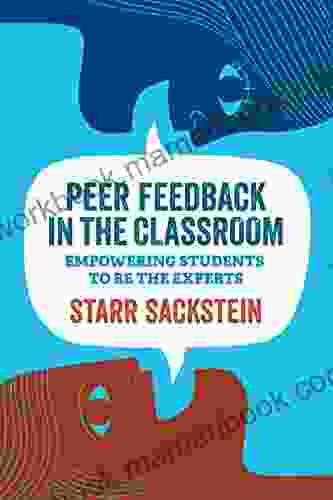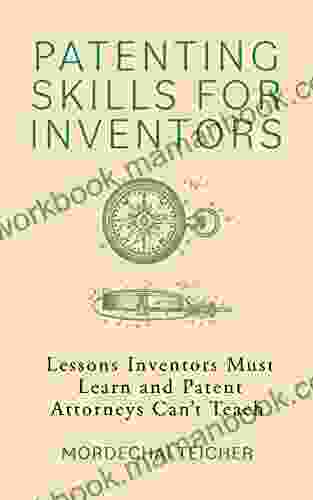Mastering the Art of Patenting: A Comprehensive Guide for Inventors

In the realm of invention, where creativity and innovation collide, the pursuit of patents holds immense significance. Patents are legal instruments that grant inventors exclusive rights to their creations, fostering an environment conducive to innovation and progress. To navigate the intricate world of patenting, inventors must equip themselves with a robust skillset that encompasses technical expertise, legal acumen, and strategic planning. This comprehensive guide delves into the essential skills required to excel in the art of patenting, empowering inventors to protect their intellectual property, gain recognition, and drive the frontiers of innovation.
4.6 out of 5
| Language | : | English |
| File size | : | 441 KB |
| Text-to-Speech | : | Enabled |
| Screen Reader | : | Supported |
| Enhanced typesetting | : | Enabled |
| Print length | : | 158 pages |
| Lending | : | Enabled |
1. Understanding the Patentability Criteria
The foundation of successful patenting lies in a thorough understanding of the criteria that determine whether an invention is eligible for patent protection. These criteria, established by patent laws and regulations, provide clear guidelines for assessing the novelty, utility, and non-obviousness of an invention. Inventors must meticulously examine their creations to ensure they meet these stringent requirements, paving the way for a successful patent application.
- Novelty: The invention must be new and not anticipated by any prior art, including published documents, patents, or publicly available knowledge.
- Utility: The invention must possess a practical use or application that provides a tangible benefit or solves a technical problem.
- Non-obviousness: The invention must not be obvious to a person skilled in the relevant field based on existing knowledge or technology.
2. Crafting a Compelling Patent Application
Once the patentability criteria are satisfied, inventors must meticulously craft a patent application that effectively communicates the essence of their invention. This comprehensive document serves as the blueprint for the invention, outlining its technical details, benefits, and potential applications. To increase the likelihood of success, inventors should adhere to specific guidelines and follow structured formats established by patent offices worldwide.
A well-drafted patent application comprises several key elements:
- Title: A clear and concise title that captures the essence of the invention.
- Abstract: A brief summary of the invention, including its technical aspects and benefits.
- Background: A description of the existing technology and the problem that the invention addresses.
- Description of the Invention: A thorough explanation of the invention's structure, functionality, and operation.
- Claims: Legally defined statements that delineate the scope of protection sought for the invention.
3. Navigating the Patent Examination Process
After submission, patent applications undergo a rigorous examination process conducted by patent examiners. These experts assess the application's compliance with patentability criteria, scrutinize the invention's claims, and issue Office Actions outlining any objections or requests for clarification. Inventors must possess the skills to effectively respond to these Office Actions, providing additional information, amending claims, or making necessary modifications to the invention to address the examiner's concerns.
The examination process can be iterative, requiring multiple rounds of communication and revisions. Inventors must remain persistent and adaptable, demonstrating a deep understanding of their invention and the legal framework surrounding patents. By engaging in constructive dialogue with patent examiners, inventors can increase the likelihood of obtaining a strong and enforceable patent that fully protects their intellectual property.
4. Strategic Patenting and Commercialization
Beyond the initial patent grant, inventors must consider the strategic management of their intellectual property to maximize its commercial potential. This involves making informed decisions regarding patent maintenance, licensing, and enforcement. Inventors should possess a keen understanding of the competitive landscape, industry trends, and potential market opportunities to effectively monetize their inventions.
Strategic patenting involves filing multiple patents to cover different aspects of an invention, expanding the scope of protection and deterring potential competitors. Inventors should also consider filing patents in multiple jurisdictions to gain international protection for their creations. By proactively managing their patent portfolio, inventors can create a robust foundation for commercial success, attracting investors, forming strategic partnerships, and establishing a strong competitive advantage in the marketplace.
5. Enforcing and Defending Patents
Patents are powerful legal tools that can be leveraged to protect against infringement and safeguard the exclusive rights of inventors. When infringement occurs, inventors must be prepared to enforce their patents through legal action. This may involve filing infringement lawsuits, obtaining injunctions to prevent further infringement, or negotiating licensing agreements with potential infringers.
In addition to enforcement, inventors may also face challenges to the validity of their patents. These challenges can arise from competitors, third parties, or even the patent office itself. Inventors must possess the skills to defend their patents against such challenges, providing evidence of the invention's novelty, utility, and non-obviousness. By proactively monitoring their patents and staying abreast of legal developments, inventors can maintain the integrity of their intellectual property and protect their rights as inventors.
The art of patenting requires a diverse skillset that encompasses technical expertise, legal acumen, and strategic planning. By mastering these essential skills, inventors can navigate the complexities of the patent system, protect their creations, and fuel innovation across industries. This comprehensive guide has provided a roadmap for inventors to enhance their patenting capabilities, empowering them to secure exclusive rights to their inventions, gain recognition for their creativity, and drive the progress of society through technological advancements.
4.6 out of 5
| Language | : | English |
| File size | : | 441 KB |
| Text-to-Speech | : | Enabled |
| Screen Reader | : | Supported |
| Enhanced typesetting | : | Enabled |
| Print length | : | 158 pages |
| Lending | : | Enabled |
Do you want to contribute by writing guest posts on this blog?
Please contact us and send us a resume of previous articles that you have written.
 Top Book
Top Book Novel
Novel Fiction
Fiction Nonfiction
Nonfiction Literature
Literature Paperback
Paperback Hardcover
Hardcover E-book
E-book Audiobook
Audiobook Bestseller
Bestseller Classic
Classic Mystery
Mystery Thriller
Thriller Romance
Romance Fantasy
Fantasy Science Fiction
Science Fiction Biography
Biography Memoir
Memoir Autobiography
Autobiography Poetry
Poetry Drama
Drama Historical Fiction
Historical Fiction Self-help
Self-help Young Adult
Young Adult Childrens Books
Childrens Books Graphic Novel
Graphic Novel Anthology
Anthology Series
Series Encyclopedia
Encyclopedia Reference
Reference Guidebook
Guidebook Textbook
Textbook Workbook
Workbook Journal
Journal Diary
Diary Manuscript
Manuscript Folio
Folio Pulp Fiction
Pulp Fiction Short Stories
Short Stories Fairy Tales
Fairy Tales Fables
Fables Mythology
Mythology Philosophy
Philosophy Religion
Religion Spirituality
Spirituality Essays
Essays Critique
Critique Commentary
Commentary Glossary
Glossary Bibliography
Bibliography Index
Index Table of Contents
Table of Contents Preface
Preface Introduction
Introduction Foreword
Foreword Afterword
Afterword Appendices
Appendices Annotations
Annotations Footnotes
Footnotes Epilogue
Epilogue Prologue
Prologue Gary Neal Hansen
Gary Neal Hansen Stephen Parkes
Stephen Parkes Kaveh Akbar
Kaveh Akbar Alex Messenger
Alex Messenger Elisabeth Charpentier Leuxe
Elisabeth Charpentier Leuxe Nol Alembong
Nol Alembong Salathia Omega Scott
Salathia Omega Scott Gwyneth Moore
Gwyneth Moore Irene Black
Irene Black Wilbur Smith
Wilbur Smith Elisabeth Robson
Elisabeth Robson Ian Johnston
Ian Johnston Pamela Chanko
Pamela Chanko Alex Lancer
Alex Lancer Jeanna Ganas
Jeanna Ganas Hal Burton
Hal Burton Val Kaplan
Val Kaplan Gary Taubes
Gary Taubes Lisa Marie Rice
Lisa Marie Rice Ginnie L Hansen
Ginnie L Hansen
Light bulbAdvertise smarter! Our strategic ad space ensures maximum exposure. Reserve your spot today!

 Kenzaburō ŌeWordwaves Poems: A Journey through the Poetic Landscape with Elsa Colligan's...
Kenzaburō ŌeWordwaves Poems: A Journey through the Poetic Landscape with Elsa Colligan's... Jay SimmonsFollow ·9.2k
Jay SimmonsFollow ·9.2k Theo CoxFollow ·7k
Theo CoxFollow ·7k Pablo NerudaFollow ·11.9k
Pablo NerudaFollow ·11.9k Julian PowellFollow ·11.9k
Julian PowellFollow ·11.9k Enrique BlairFollow ·14.5k
Enrique BlairFollow ·14.5k Chad PriceFollow ·5.7k
Chad PriceFollow ·5.7k Jared PowellFollow ·5.5k
Jared PowellFollow ·5.5k Dashawn HayesFollow ·3.1k
Dashawn HayesFollow ·3.1k

 Terry Bell
Terry BellEmpowering Students to be the Experts: Reshaping the...
Traditional...

 Raymond Chandler
Raymond ChandlerShangri La Frontier 82 Katarina: A Comprehensive Analysis...
: Unveiling...

 Oscar Bell
Oscar BellThe King Slater 11: Monsters
In the eleventh installment of the bestselling...

 Rex Hayes
Rex HayesEmpath Empathy: Uncovering the Profound Powers and...
: The Enigma of Empaths In...

 Wade Cox
Wade CoxAn Abi Button Cozy Mystery Romance: A Love Story with a...
In the quaint and charming...
4.6 out of 5
| Language | : | English |
| File size | : | 441 KB |
| Text-to-Speech | : | Enabled |
| Screen Reader | : | Supported |
| Enhanced typesetting | : | Enabled |
| Print length | : | 158 pages |
| Lending | : | Enabled |












